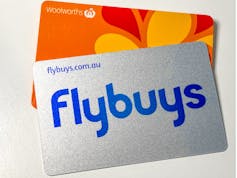By Alexandru Nichifor & Scott Duke Kominers*
Loyalty programs enable firms to offer significantly lower prices to some of their customers. You’d think this would encourage strong competition.
But that isn’t always what actually happens. New research shows that paradoxically, by changing the way companies target customers, loyalty programs can sometimes reduce price competition. The research also points to solutions.
A win-win proposition?
Joining a loyalty program is supposed to be a win-win. You – the customer – get to enjoy perks and discounts, while the company gains useful commercial insights and builds brand allegiance.
For example, a hotel chain loyalty program might reward travellers for frequent stays, with points redeemable for future bookings, upgrades or other benefits. The hotel chain, in turn, records and analyses how you spend money and encourages you to stay with them again.

Such programs are commonplace across many industries – appearing everywhere from travel and accommodation to supermarket or petrol retailing. But they are increasingly coming under scrutiny.
In 2019, the Australian Competition and Consumer Commission (ACCC) cautioned consumers about the sheer volume of personal data collected when participating in a loyalty program, and what companies can do with it.
Hidden costs – such as having to pay a redemption fee on rewards or losing benefits when points expire – are another way these schemes can harm consumers.
But a larger question – how loyalty programs impact consumers overall – remains difficult to settle, because their effect on competitiveness is unclear. As the ACCC’s final report notes, on the one hand:
Loyalty schemes can have pro-competitive effects and intensify competition between rivals leading to competing loyalty discounts and lower prices for consumers.
But on the other hand:
Loyalty schemes can also reduce the flexibility of consumers’ buying patterns and responsiveness to competing offers, which may reduce competition.
How a two-speed price system can hurt everyone
A new economic theory research working paper, coauthored by one of us (Kominers), suggests that on competitive grounds alone, loyalty programs can sometimes harm all consumers – both ordinary shoppers and the program’s own members.

It’s easy to see how the ordinary shopper can be worse off. Since a firm’s loyalty program enables it to offer discounted prices to its members, the firm can raise the base prices it offers to everyone else. Those not participating in the program pay more than they otherwise would have, and the firm can respond by saying “join our program!” instead of having to lower its price.
But sometimes, even the program’s own members can end up worse off.
When a given customer’s loyalty status is not visible to a firm’s competitors – as is the case in many loyalty programs today – it’s hard for those competitors to identify them and entice them to switch.
The main way to compete for those customers becomes to lower the base price for everyone, but this means missing out on the high base margins achieved through the existence of your own loyalty program – remember, having a loyalty program means you can charge non-members more.
It’s often more profitable for firms to just maintain high base prices. This, in turn, reduces overall price competition for loyal customers, so firms can raise prices for them, too.
What’s the solution?
Despite these effects on competition, loyalty programs still offer benefits for consumers and an opportunity for brands to form closer relationships with them.
So, how do we preserve these benefits while enabling price competition? The research suggests an answer: making a customer’s loyalty status verifiable, transparent and portable across firms. This would make it possible for firms to tailor offers for their competitors’ loyal customers.
This is already happening in the market for retail electricity. While there aren’t loyalty programs there per se, a consumer’s energy consumption profile, which could be used by a competitor to calibrate a personalised offer, is known only to their current electricity supplier.
To address this, in 2015, the Victorian government launched a program encouraging households to compare energy offers. This process involved first revealing a customer’s energy consumption profile to the market, and then asking retailers to compete via personalised offers.
By opening information that might have otherwise been hidden to the broader market, this approach enabled firms to compete for each other’s top customers, in a way that could be emulated for loyalty programs.

Such systems in the private sector could build upon “status match” policies at airlines. These allow direct transfer of loyalty status, but currently rely on a lengthy, individual-level verification process.
For example, a design paradigm known as “Web3” – where customer transactions and loyalty statuses are recorded on public, shared blockchain ledgers – offers a way to make loyalty transparent across the market.
This would enable an enhanced, decentralised version of status match: a firm could use blockchain records to verifiably identify who its competitors’ loyal customers are, and directly incentivise them to switch.
Both startups and established firms have experimented with building such systems.
What next?
New academic research helps us model and better understand when loyalty programs could be weakening supply side competition and undermining consumer welfare.
A neat universal solution may prove elusive. But targeted government or industry interventions – centred on increasing the transparency of a customer’s loyalty status and letting them move it between firms – could help level the playing field between firms and consumers.![]()
*Alexandru Nichifor, Associate Professor, Faculty of Business and Economics, University of Melbourne, The University of Melbourne and Scott Duke Kominers, Sarofim-Rock Professor of Business Administration, Harvard University.
This article is republished from The Conversation under a Creative Commons license. Read the original article.
8 Comments
Don't forget Mitre10/bunnings we'll beat it by x% actually raises prices too. Other businesses can't sell for cheaper because they won't get the sale as everyone will just use that rpice to get it cheaper from the big boys.
This is a form of price setting where a retailer gets to set the price that other retailers follow. I.e. it becomes an oligopoly.
Were a member of the oligopoly to break from the oligopoly and say, "We'll beat [retailer leading the price setting] prices by 5%", then the price setting oligopoly simply gets a new price leader, and consumers get a benefit for probably only a few months.
One of the issues with modern technology is that it enables extremely rapid pricing adjustments so the oligopolies can all profit from it. I can't see any answers to this conundrum. Any suggestions?
Loyalty schemes are a thinly disguised scam......
They redistribute money in a way that is unlikely to be fair or efficient.
I strongly urge consumers to keep in mind the old wisdom, "If it seems too good to be true, it probably is."
We're all likely to be better off without loyalty schemes.
Pyramid schemes are banned under legislation - and loyalty schemes ought also to be banned.
TTP
I had one vendor (won't be hard for the savvy to figure out who) refuse to match Mitre 10's price on a product recently, despite their "just let us know and we'll match it" claim.
They hid behind their conditions:
All price matching is at the discretion of <vendor> and is subject to change at any time.
...which I'm fairly sure would have them over a barrel at the ComCom - marketing a price match is deceptive if they can just weasel out of it.
Ultimately my conscience prevented me from reporting this, because they're competing against the 15% offer which is unsustainable for any business not on the scale of M10/Bunnings (and with a fraction of their legal department).
Most of the cards are a waste of time but I use ASB True Rewards and when I remember to use it, most time in Mitre 10 the purchase is free with the dollars accumulated. Obviously a Mobil card is great and the supermarket cards are pretty good to.
Silly question time - Can someone explain to me why you'd want to be 'loyal' to a particular store, retailer or brand? I mean, what's really in it for you?
Why aren't the primary considerations:
- Price
- Quality
- Availability
- Access (far bigger issue than most realize thanks to poor urban planning)
So why use loyalty cards?
- Is evaluating those considerations (above) just too hard?
- Snobbery? e.g. "I'd not be seen dead at Pak'n'Save!"
- Dog eat dog? i.e. "I'm getting a saving that others aren't."
- Damned if you do. Damned if you don't?
- Something else?
It seems to me the only winners are the sellers while the customer is being conned into thinking they are getting something 'for free' whereas they're actually not. In fact, they're actually being led through the nose.
My view is they're market distorting and a con. Thus, they should be banded for most retailers, especially supermarkets.
IMO you are correct those other considerations are more important - but even within them you are making trade offs based on what suits you best or your needs most of the time i.e. location vs price ,,, it's all a complicated balance act. "loyalty" is like the cherry on top once you have settled on a store / brand that best suits you most of the time, and you now get something for nothing.
Like a prudently-used credit card, a loyalty card can be a well-wielded tool in the hands of a savvy consumer. Such a consumer will buy in bulk according to the ebb and flow of supermarket specials, scoring the "discounted" price all the time. The cleverer consumer will have done their homework enough to know the proper base price of their purchases, and which chain is optimal for them.
The cleverest consumer will have used an obfuscated identity and burner contact details when "registering" their card so they've got some degree of immunity from data-mining and marketing.
Of course that very smart consumer is only ever an unexpected expense or windfall away from being too panicked/busy/happy/carefree to stick to their guns. Just as surely as they'll fall behind on credit card payments and end up bleeding interest, they'll lose track of their loyalty commitments eventually. Maybe they buy snacks mid-week, maybe they convince themselves "it's okay this one time" because their receipt shows their card still saved them $0.40. But once the pattern of diligence breaks it's very hard to put back in place. And so they care a little less, and their loyalty (now more an ingrained habit) sees the house winning once again.
Speaking for myself, Countdown's (ugh, Woolworths') new loyalty scheme is dreck, intrusive, and riddled with fishhooks. They've lost me as a customer, the irony being that now I'll fork out more at Fresh Choice to line the pockets of the same masters.
We welcome your comments below. If you are not already registered, please register to comment.
Remember we welcome robust, respectful and insightful debate. We don't welcome abusive or defamatory comments and will de-register those repeatedly making such comments. Our current comment policy is here.